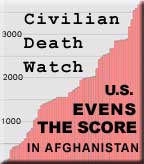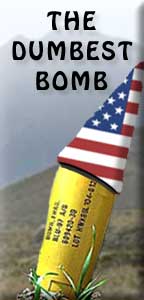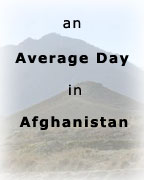The Failing Campaign to Kill Jalaluddin Haqqani
by Marc W. Herold
POSTED JANUARY 18, 2002 -- Chasing and bombing shadows? For two months now, the Pentagon has been carrying out a relentless bombing campaign seeking to kill Maulvi Jalaluddin Haqqani. The effort has failed, just as has the drive to apprehend Mullah Omar and Osama Bin Laden.
But who is Jalalludin Haqqani and why he is deserving of such Pentagon attention? With what effects?

A report filed by Reuters on October 9th, pondering the future of the Taliban, pointed to the prominence of Jalaluddin Haqqani:
"One of the main weathervanes will be Jalaluddin Haqqani, the most prominent Mujahideen commander from the Soviet war who sided with the Taliban when they made him minister for tribal affairs. Haqqani has returned to his stronghold in Khost, the eastern border area where Saudi-born militant Osama bin Laden reportedly had several training camps, and Afghan analysts are watching to see if he will turn coat and support Zahir Shah."1
A veteran mujahideen and northern Pashtun, Haqqani rose to prominence as a military leader of the radical Islamic group and militia of Pashtun resistance to the Soviet-leaning communist government in Kabul, Hezb-e-Islami of Gulbuddin Hekmatyar, during the 1980s.
At the time, he was a strong ally of the United States. Hekmatyar in turn retains strong ties with Iran. Haqqani's power base resided in Jalalabad and particularly in Khost, Paktia. Jalaluddin Haqqani played a pivotal role between the southern Pashtuns from Kandahar who formed the core of the Taleban, and what that group sees as the northern usurpers from the capital of Kabul.
Haqqani was renowned as the architect of one of the most stunning military reverses suffered by the Najibullah government - the fall of Khost in 1991. He was named justice minister in the first mujahideen government formed in Kabul in 1992, but defected to the Taliban just before they seized the capital in September 1996. In 1995, Haqqani defected and allied himself with the emerging Taliban and helped the Taliban secure control of Nangarhar Province in 1996. The defection was a key factor in securing territorial advantage for the emerging Taliban.2 At the time, Bin Laden was living there as a guest [and friend] of Haqqani. Haqqani possessed a valuable trove of apparently at least 70 U.S. Stinger missiles.3
Haqqani led the Taliban's brutal military campaign north of Kabul during the winter of 1996/7, sweeping through the towns of Estalif and Qarabagh, carrying out what his opponents described as ethnic cleansing of the Tajik minority there.
In 1998, he switched posts, being appointed to the important position of Minister of Tribal and Border Affairs in the Taliban government. Haqqani is known to have had close ties with Pakistan's intelligence agency, the I.S.I., dating back to the 1980s. His relationship with Bin Laden led to the building of many training camps in the eastern provinces of Nangarhar and Paktia [especially south of Khost]. The Zhawar Kili Al Badr camps in the Khost area were targeted and hit with some 70 cruise missiles when Washington launched its first strike against bin Laden in 1998 after the bombings of U.S. embassies in Kenya and Tanzania. In late September 2001, Omar appointed Haqqani as commander-in-chief of the Taliban armed forces. He also served as governor of Paktia.
During the first month and a half of the U.S. Afghan War, the belief existed in Washington that the heavy U.S. bombing would lead to splits within the Taliban leadership. Some thought that a moderate Taliban faction might regroup in Pakistan and disassociate itself from Kabul. Haqqani was seen as one possible leader of such a splinter fraction. During the first four weeks of the air campaign, U.S. planes studiously avoided hitting Afghanistan's largest and most fortified training camps burrowed into the mountains east of Khost in Paktia province.4 This area reportedly hosted five Haqqani bases, partly built by Osama Bin Laden when he was an American ally.
Much ado was made in the Western press of Haqqani's visit to Pakistan between October 17th - 21st. Such speculation dissipated when Jalaluddin commented to local reporters during his trip:
"We will retreat to the mountains and begin a long guerrilla war to reclaim our pure land from infidels and free our country like we did against the Soviets….We are eagerly awaiting the American troops to land on our soil, where we will deal with them in our own way….The Americans are creatures of comfort. They will not be able to sustain the harsh conditions that await them."5
Three weeks later the U.S. began its bombing campaign targeted specifically at killing Jalaluddin Haqqani. In the confusion reigning in Kabul on November 11/12th, as the Taliban lines in the north had collapsed, Kathy Gannon reported for the A.P. that a lieutenant of Haqqani was the contact person between the Taliban and "the Arabs" of Al Qaeda.6
The first U.S. strike at Haqqani occurred in Kabul on the night of November 12th, when his two-story house in the upscale district of Wazir Akbar Khan was presumably targeted. Neighbors said Taliban, Arab, Pakistani, and Sudanese fighters regularly had visited the house and it was linked by a communications wire to a heavy artillery position on the Bibi Mahru hill.7
The area around Haqqani's house was hit three times. At 7 p.m. that night, a 500 lb Mark 82 JDAM bomb -- America's weapon of choice during the first phase of the U.S. air war -- hit a small group of buildings opposite his home, destroying a guard hut where ammunition was stored and flattening a civilian house. Just 30 minutes later neighbors saw several people loading ammunition into a Toyota van in the street. Seconds later, a U.S. helicopter circling overhead fired a rocket directly into the van, vaporizing it.
Ghulam Ali's sister-in-law, Ayesha, 30, was drawing water from a barrel in her front yard nearby when it struck. Ayesha was killed instantly by shrapnel.
Scoreboard: a 30 year old woman killed, a civilian house flattened, and Haqqani somewhere in Afghanistan.
Then, on November 13th, U.S. planes attacked a house in which they believed Jalaluudin was staying at in Gardez, the capital of Paktia. Haqqani survived the attack, but his brother-in-law and a family servant were killed.
Scoreboard: a civilian servant and a relative of Haqqani killed, a house destroyed, and Haqqani somewhere in Afghanistan.
A couple of days later, November 18th, Behroz Khan of Pakistan's The News provided details of another attack:8
"Another 18 persons, including six bodyguards of Taliban Minister for Frontiers, Maulvi Jalaluddin Haqqani and the entire family of his host, Maulvi Sirajuddin was killed in Tosha village of the Zadran area in Paktia province. "We have reports the family members of the host were martyred in the bombing. But my father is safe and is inside Afghanistan," said the son of Maulvi Jalaluddin Haqqani. Locals from Tosha village said that the bomb was dropped on the house at midnight, which killed Maulvi Sirajuddin and his 11-member family. Six of Haqqani's bodyguards were also killed…."
Two days earlier, November 16/17th , U.S. planes had bombed a mosque and the attached religious seminary [the Madrassah of Haqqani] on the outskirts of Khost, which had resulted in the death of 15 students at the religious school as well as another 10 at the mosque. The planes attacked when the mosque was full during the late evening Isha's and Taraweh prayers.
Scoreboard: 11 family members, 15 teenage religious students and 10 civilians in mosque killed, a mosque, madrassah and house destroyed, and Haqqani somewhere in Afghanistan.
By December , Haqqani had apparently vanished from sight. A month later, Paktia Governor Badshah Khan, a Pashtun royalist, fearing rebellion by local tribal chiefs in the border areas with Pakistan, was expressing reservations about the renewed U.S. bombing campaign on training camps south of Khost during the previous 10 days. Khan was quoted as saying,
"If Americans are really interested in removing Al Qaeda, instead of destroying our tribal structure and creating differences between our people, they have to help the powerful ones - like me - not just the Northern Alliance from Kabul, which is trying to undermine our rule...I didn't believe before all this that the Americans could be so foolish - bombing villages instead of military targets. They are repeating some of the mistakes of Tora Bora all over again."11
After more than two months of seeking and failing to kill Taliban Minister Jalaluddin Haqqani what is the scorecard?
- 38 civilians killed
- 3 residences destroyed
- A mosque and religious school bombed
-- 30 --
Footnotes
1 Tom Heneghan, "Analysis---Race on for Hearts and Minds of Afghan Tribes," Reuters [October 9, 2001].
2 Some details on Haqqani from Sukumar Muralidharan, "America's War. Into a Crucial Phase," Frontline 18, 22 [Oct. 27 - Nov. 9, 2001].
3 "Haqqani Appointed Taliban Commander," Dawn [September 29, 2001].
4 Christopher Kremmer in New Delhi, "Warlord Plots Future Minus Taliban Friends," The Age [October 22, 2001].
5 Scott MacDonald, "Minister's Visit Hints at Taliban Split," Reuters, Islamabad [9:38 AM ET, October 20, 2001]. Also "Taliban Official in Talks Over New Leadership," OC Register [October 21, 2001].
6 Kathy Gannon, "Taliban's Defiance Masks Move to Flee," Associated Press [November 30, 2001].
7 Rory McCarthy, "U.S. Planes Rain Death on the Innocent. 'Precision' Raids kill Residents in Capital City," The Guardian [December 1, 2001].
8 Behroz Khan, "Taliban Spilt Over pullout from Kunduz," The News International [November 19, 2001].
9 Rahimullah Yusufzai, "US Warplanes Now Targeting Civilians," The News International [December 12, 2001].
10 see Ellen Knickmeyer, "Civilians Flee US Bombing Raids on terrorist Hideout," The Guardian [January 14, 2002], and Suzanne Goldenberg, in Zhawar, "Day 100: Another Raid in the Bombing war Without End," The Guardian [January 15, 2002].
11 Philip Smucker, "US Beefs Up Troops, but Skips Locals," Christian Science Monitor [January 16, 2002].


